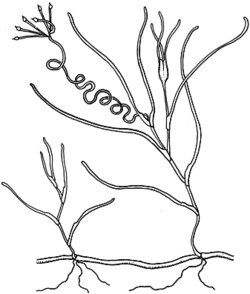
Description: Perennial or annual submerged aquatics with elongate rhizomes; turions present or absent; stems erect, elongated or very short.
Leaves with blade narrow-linear, apex entire or notched; sheath loose, non-ligulate, auriculate.
Inflorescence 2-flowered, the peduncle elongating and the spike emerging either just above the leaves or to the surface. In surface-flowering species the peduncle becomes loosely to tightly coiled, pulling the flowers below the surface as the carpels mature. Perianth absent. Carpels 2–19, free, 1-locular, initially sessile or subsessile but the stipe sometimes elongating; ovule 1.
Drupelets ± asymmetrical, each on a stipe that sometimes becomes reflexed, drupelets usually falling with stipe still attached; endocarp with a stylar beak.
Distribution and occurrence: World: 1 genus, 11 species, cosmopolitan; Australia: 4 species (native), all States.
Previously placed in Potamogetonaceae
Text by S. W. L. Jacobs & S. Papassotiriou. Key updated by Kerry Gibbons 5 June 2023, from S.W.L. Jacobs, M.A. Brock, Flora of Australia Online [accessed 5 June 2023]; page updated by H. Sauquet (Mar 2025).
Taxon concept:
| | Key to the species | |
| 1 | Mature fruiting carpels sessile or subsessile, the stipe always much shorter than the carpel | Ruppia tuberosa |
| Mature fruiting carpels with an elongate stipe always longer than the carpel | 2 |
| 2 | Inflorescence stalk usually less than 5 cm (always less than 10 cm long), at the most once or twice loosely coiled; flowers pollinated and maturing entirely submerged | Ruppia maritima |
| Inflorescence stalk flexuous, usually more than 10 cm long (always more than 5 cm long), coiled several times, pollination occurring at the surface and the flowers then retracted by the coiling peduncles to mature submerged
Back to 1 | 3 |
| 3 | Leaves with apex obtuse; carpels mostly 6–8; fruit 3–4 mm long; endocarp perforations narrow-triangular | Ruppia polycarpa |
| Mature leaves with apex truncate or notched; carpels usually 4; fruit 2–3 mm long; endocarp perforations broad-triangular
Back to 2 | Ruppia megacarpa |
|


